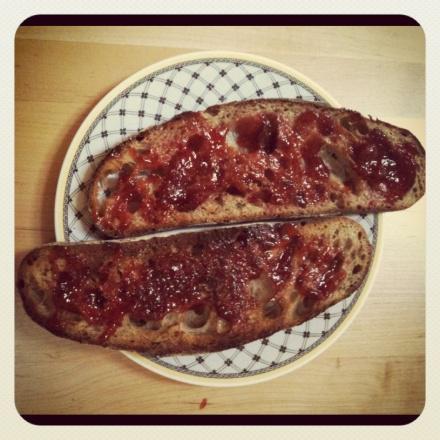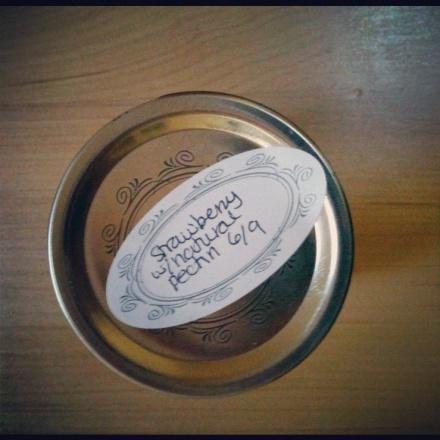If you get too deep into something, whatever it is, people seem to need to divide themselves into camps. Even canners have their factions. (Yes, really). When I first started reading up on canning a few years ago, a New York Times article noted that certain canners eschewed store-bought pectin. They craft their jam either by cooking down the preserves until the gel point is reached, or by making their own pectin. Considering the sum of my knowledge on pectin was that it was a “white powder” that is added to boiling fruit, I had a hard time conceiving of how on earth these folks were making their own. And, I’ll admit, it seemed a little die-hard.

Pectin it turns out, is just a natural compound in fruit that, reacting with sugar, acid, and heat, allows jam to set and jelly to jell (otherwise, you’d get syrup). Some fruits have more than others, with green apples and citrus being particularly high. You can cook down (most) fruits until they jell on their own–this is a long process as the water slowly evaporates–or you can use pectin to speed things up.
After agonizing philosophical inquiry I’ve decided that I have no metaphysical qualms about using store-bought pectin, but even so, I hardly use it. Rather than principles it’s due to practicality: I hardly ever manage to find powder pectin, and liquid pectin even less in our local stores. And I just never get around to ordering online, which is odd given how much I do order online (cough cough). I will note that there is one reason I do like avoiding store-bought pectin, which is the amount of sugar required (although low-sugar pectins are available). Jam making tends to require horrifying amounts of the stuff.
I’ve been mainly making those slow-cooked jams which are delicious but time consuming to make. And I guess I’ve turned the canning geek corner, because for some reason I got excited about a recipe in my Ball cookbook using a homemade “applesauce” as pectin. So here we are.

And…I loved making this recipe! The novelty of using applesauce to set the jam makes it fun, and one definitely get DIY props for doing it this way. And while it may take just as much time as a no-pectin recipe (taking into account the time to make the applesauce) it’s a lot more hands off–a decided improvement over 40 minutes of constantly stirring a steaming hot liquid. This recipe uses less sugar than comparable recipes, and (since you’re not boiling away all that liquid) you get a better yield than no-pectin recipes for the same amount of fruit. And in case you were worried, there is no weird applesauce flavor substrate interfering with things–just pure strawberry intensity.
As you’ll see from the pictures I’ve been sitting on this recipe for far too long. I’m now rushing to get it out in the hopes of being a useful pal for the last waning days of strawberry season, so pardon the lack of pithy observations. Even if you’re on to the next fruits of summer where you live, know that you can use natural pectin for a whole host of fruit recipes. I know I’ll be trying more of it this summer.
If you’re curious, here’s my maiden voyage into strawberry jams from three years ago

Strawberry Jam with Natural Fruit Pectin adapted from the Ball Complete Book of Home Preserving
Yield: 7-8 half pint jars.
Note: You will need a food mill to make the applesauce. If you don’t have one, I would expect you could peel the apples, and gather the seeds, cores, and peels in cheesecloth, and simmer these along with the apples when you make the sauce, to extract even more pectin. Then discard when you go to puree your mixture.
As always, if you are new to canning, check out safety considerations and procedures at the National Center for Home Food Preservation. I only provide an abbreviated discussion so please read up.
- 5 tart apples such as Granny Smith apples, stem and blossom ends removed, coarsely chopped, cores intact and unpeeled.
- 1 lemon or lime (unpeeled), finely chopped
- water
- 8 cups halved hulled strawberries
- 5 1/2 cups granulated sugar
In a large, deep stainless steel saucepan, comine the apples (including the cores), chopped lemon, and just enough water to prevent scorching. Bring to a boil over high heat, and then reduce to medium low. Allow to simmer for about 20 minutes, or until the apples are soft. Run the cooked mixture through a food mill–this will remove the cores and seeds–until you measure out two cups of “applesauce.”
Prepare your canning equipment and begin heating your water to sterilize your jars (bring jars to a rolling boil for 10 minutes). Prepare your lids and rings.
In a deep saucepan (it can be the same one you used for your applesauce if you wipe it out to make sure there are no leftover seeds or bits of skins) combine the applesauce, strawberries, and sugar. Bring to a boil over medium heat, stirring to ensure the sugar dissolves. Boil, stirring, until the mixture thickens. This takes about twenty minutes. The Ball cookbook suggests cooking until the jam mounds on a spoon, but this didn’t seem to happen for me–I found using the cold plate test more helpful and it proved to be accurate.
Make sure to skim the foam off the top of the jam before filling the jars.
Ladle the hot jam into the prepared jars, leaving 1/4″ headspace. Remove any airbubbles, wipe the rims clean, put on the lids, and screw on the rings fingertip-tight.
Return the jars to the boiling water bath, return to a rolling boil, and process for 10 minutes. Turn off the heat, let the jars sit in the water for another five minutes, then remove from the hot water (this helps prevent siphoning). Allow to cool, and check that jars have sealed.

